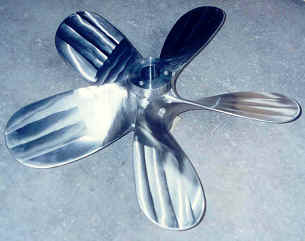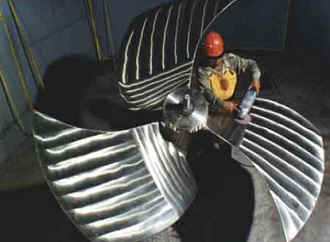|
|
||||||||||||||||||||||||||||||||||||||||||||||||||||||||||||||||||||||
|
|
||||||||||||||||||||||||||||||||||||||||||||||||||||||||||||||||||||||
|
||||||||||||||||||||||||||||||||||||||||||||||||||||||||||||||||||||||
|
|
||||||||||||||||||||||||||||||||||||||||||||||||||||||||||||||||||||||
|
The
superiority of Mn - Ni Al bronze (Aqualloy) has been convincingly
demonstrated by its characteristics of service, in which has been
demonstrated to be the good enough, for the work in marine environment.
|
Desde el escritorio de
Alejandro Aguilar |
|||||||||||||||||||||||||||||||||||||||||||||||||||||||||||||||||||||
|
Propeller efficiency:
It is important to highlight that propellers made of Aqualloy bronze as well
as those of stainless steel, retain their original smooth machined surface
over a long period of time, conserve the factor of efficacy the time over. Numerically the increase in efficiency would lie in
the order of 1.5- 3.0%, in the Aqualloy bronze and decrease in the stainless
steel for its higher weight due to bigger material density, approximately a
10% heavier than Aqualloy bronze propellers would have an advantage in fuel
savings due to its weight, also efficiency will also depend on the size of
the propeller, factors of design and time of service.
MECHANICAL
RESISTANCE: Because the ability of the Aqualloy bronze to resist
failure under cut impact it is the reason why it is a material widely used
to manufacture propellers. REPAIRABILITY: Aqualloy bronze is easily repairable by the process of MIG weld, or anyone, could also require or not of small preheating in order to weld, to difference of the stainless steel that if doesn't have a preheating adapted before welding, it will be subject to fractures for resistance for what it necessarily require a treatment for relief of efforts, as well as a treatment of heating for passivation of carbides and to avoid the oxidation process. PROPELLERS
COST. The reduction of weight of
Aqualloy bronze in conjunction with the increased in strength of the
material, allows the design propellers approximately of 10 % less weight
than a stainless steel propeller.
TABLE 1- CHART OF PROPERTIES OF MANGANESE - NICKEL ALUMINUM BRONZES (AQUALLOY), AGAINST STAINLESS STEEL
If
you have any suggestions or questions regarding these technical issues, or
if you know someone who's willing to receive these technical letters, or
if you wish to be removed from our mailing list, please send an
e-mail to: technicalletter@ricepropulsion.com |
||||||||||||||||||||||||||||||||||||||||||||||||||||||||||||||||||||||



